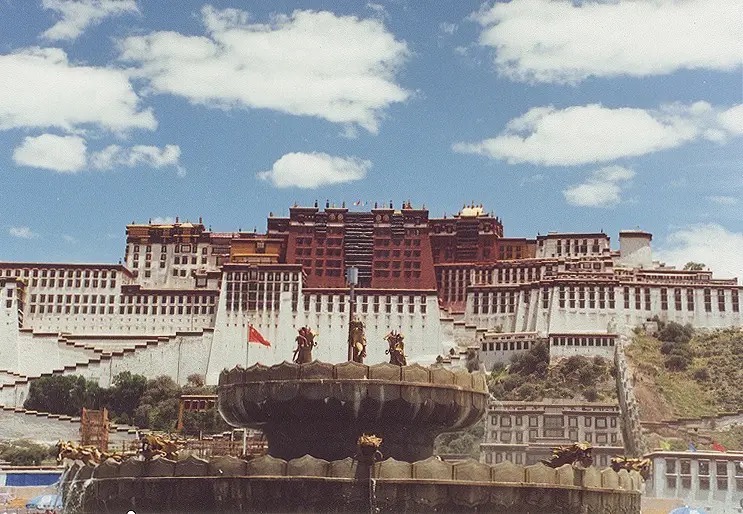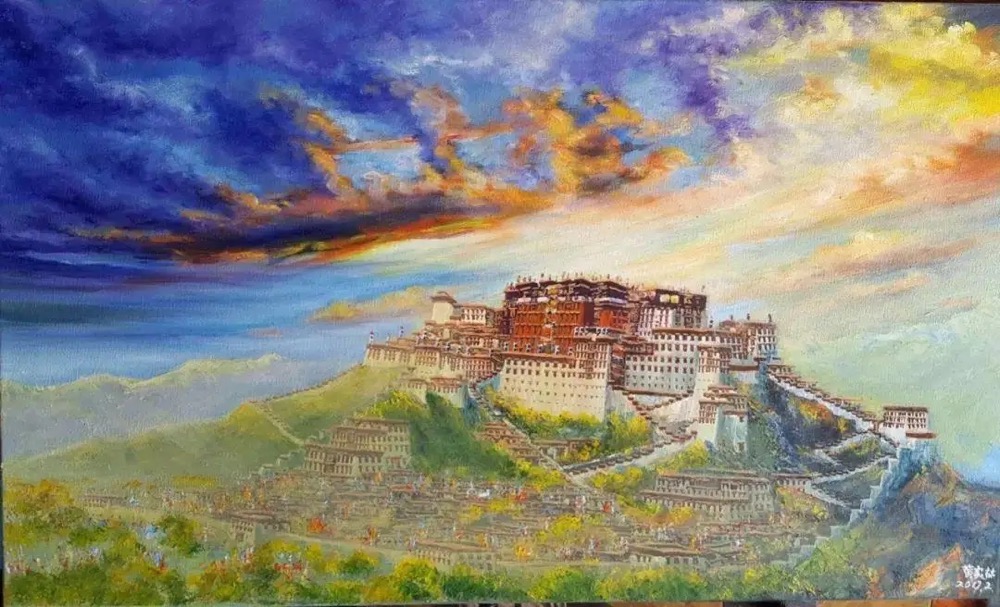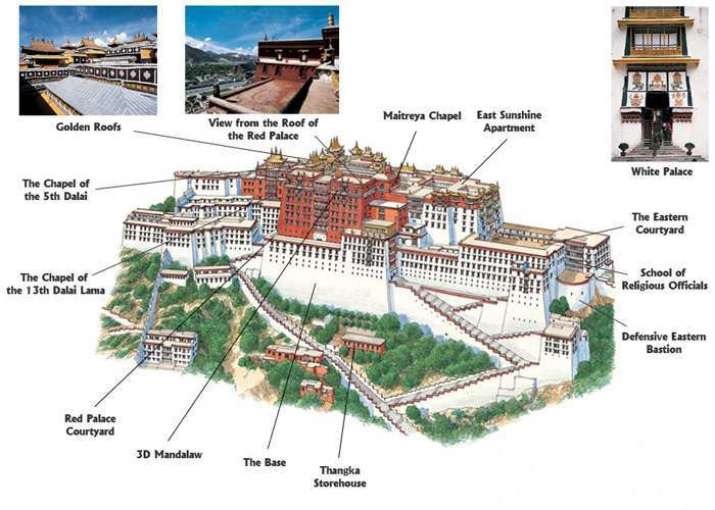In the past, kings – the political leaders of regions – lived in palaces. A palace was a residential place and also an administrative center. In the seventh century, the Tibetans had spiritual leaders who doubled up as administrative leaders. They also lived in palaces. Potala palace was one of the palaces where Dalai Lamas lived. It was mainly used during the winter because the Dalai Lama had another palace used during the other part of the year.
What is the Potala Palace?

The Potala Palace is a fortified building named after mount Potalaka and was a residential building for spiritual leaders of the Tibetan people. The Tibetan communities have great reverence and respect for their spiritual leaders. The title of their highest spiritual leader is Dalai Lama. Although palaces were mostly reserved for political leaders in most ancient and civilized societies, the Dalai Lama lived in the palaces. Their influence in the community enabled them to have significant political influence even though their primary role was spiritually leading the community. The political and spiritual power that Dalai Lama possessed made him a significant symbol in society. As such, he deserved to live in a noble palace that would distinguish him from other members of the society and make him command respect among the other leaders, especially from neighboring countries. Therefore, the Potala Palace was not only the resident of the Dalai Lama but also a symbol of governance, power, and respect.
Where is the Potala palace located?
The Palace is in Tibet. It is built on the Red Hill, also known as the Marpo Ri, about 300 meters from the valley floors. The Marpo Ri is among the major Lhasa hills close to the Palace. The other two hills are Pongwari and Wylie. Traditionally, its location was ideal for governance because it was elevated between Sera and Drepung monasteries. It is suspected that the Palace was built where the Red or White Palace existed, destroying their remains.
The exact modern location of Potala Palace is at 35 Beijing Middle Road, Lhasa, Tibet, China 850000. It is located at 3,700m above sea level, making it Palace at the highest elevation in the world.
When was Potala Palace built?

The Potala Palace was built in the 7th century, In the early 7th century, Songtsen Gampo reunited the tribes and built the capital in Luoxie (today’s Lhasa).The young king admired the culture of the Tang Dynasty, and his longing to establish alliance with that powerful empire was fulfilled by the permission of the marriage with princess Wencheng. In order to welcome the princess, Tubo people, who used to live in tents, especially built the beautiful palace for her. The palace is the predecessor of today’s world known Potala Palace. beginning in the year 1645. Its construction began three years after the end of the long clan wars in the Gtsang and Dbus provinces. It is referred to as the Tibetan civil war of 1639 to 1642. It was also seven years after Ngawang Lobsang Gyatso assumed power. It was also during this time that Lhasa was re-established as a capital. Additionally, during this period, pluralist theocracy was established in the region. It was during a period when the Tibetan political and spiritual governance was getting a serious re-organization as the region marked the end of a thirteen-year conflict.
Although the main residence of the Dalai Lama was completed within four years, some parts of the Palace, such as the assembly halls, shrines, stupas, chapels, and libraries, were completed in 1695. It was therefore completed after the death of the fifth Dalai Lama. There have also been several renovations, and some buildings have been added to the site.
Who built Potala Palace?
Ngawang Lobsang Gyatso- the fifth Dalai Lama – built the Potala Palace. Gyatso had much spiritual and administrative power compared to other Dalai Lamas because he had control over the entire Tibet region. After ending the civil war through military intervention, he is credited with unifying the entire Tibet. He was the spiritual and political leader and needed the right administration center. Gyatso did not, however, build the Palace alone as he had help from Konchog Chophel, who was the person who proposed its construction. Konchog Chophel played a key role as an advisor to Gyatso and identified the location where the Palace was built.
Why was the Potala Palace built?
The Palace was primarily built for the administration of Tibet. The Dalai Lama. The initial plan was to turn the Lhasa town into Tibet’s capital. Building a palace was, therefore, one of how the town would be changed into a capital. The Dalai Lama was to use the Palace as his official residence and for meeting dignitaries. He would also carry out his religious and administrative duties.
Apart from being an official residence, the Palace symbolized authority and power. A leader living in the Palace exuded confidence and power among the people he led. Additionally, it emphasized his power to the outside world, commanding respect from neighboring leaders. The Palace was also built to replace the palaces that existed before. A palace existed in the location where the Potala Palace was built. Finally, it was built to be a place of worship, meeting, and studying religion. Apart from having the Dalai Lama’s residence, it had chapels, assembly areas, and libraries. It was also the site for the Toms of Dalai Lamas.
What is the Potala palace used for today?
The Potala Palace is a significant tourist attraction in the region and is a significant religious landmark for Tibetan Buddhists. The Palace contains massive artifacts of religious worship and cultural practices. The design of the Palace is also a wonder travelers wish to explore. It is estimated that more than 3,000 tourists visit the Palace daily in October and July, the peak of tourism seasons.
In 1994 the Palace was listed on the UNESCO World Heritage List. There has been concern that several renovations of the Palace and the building of modern structures near the Palace might rob it of its original design.
How big is the Potala Palace?
The Palace is a thirteen-story building and contains more than one thousand rooms. It has about two hundred thousand statues and stands one hundred and seventeen meters above the Red Hill. Its apex is more than three hundred meters above the floor of the Red Hill Valley.
The palace length is about four hundred meters east-west and three hundred and fifty meters north-south. The stone wall of the building is about three meters thick and five meters thick at the foundation. The foundation is also enforced with copper to secure the building from earthquakes, which are common in the region. In ancient Tibet, the palaces were among the biggest and most secure buildings.
What is the Potala Palace made of?

The main materials that make up the Palace are stones, wood, and copper. Stones form the main components of the structure of the buildings. The stones were used to build the walls, columns, and staircases. Apart from the main structure, stones were significantly used in decoration work, especially in curving the thousands of statues in the Palace. Wood was another significant building material. It was used to build structures such as the roof, doors, partitioning, and cabinets. Wood was also used to curve some statues and enhance their appearance. Copper was also a significant material during construction. Instead of using nails, the architects decided to use copper for reinforcement. Copper was also an important foundation component, as it reinforced it against earthquakes.
The decoration was an important part of the Potala Palace. Paint made from sugar, milk, and honey was a significant component in building and annual renovation. The paint was important because it acted as a heat insulator during winter. Additionally, gold was used to make roofs and articles within the Palace.
How long did it take to build the Potala Palace?
The Potala Palace was built from 1645 to 1695. It, therefore, took 45 years to complete. The residential part of the Dalai Lama took a shorter time, and Dalai Lama was still using it as other sections of the Palace were under construction.
Why is the Potala Palace important?
The Potala Palace was important because of several reasons. First, it provided a place for religious study. A section of the Palace consisted of the library. The library consisted of religious materials that taught Buddhism, the main religion in Tibet at the time. It was also the place where the religious and administrative authorities resided. The fact that such leaders resided there made it a symbol of authority.
Currently, the Potala Palace is important because it is a cultural heritage of the Tibetans. It is also an important religious site for Buddhists across the globe. Additionally, it is a tourist attraction, thus generating income for the country. Furthermore, it is a historic site that provides important historical information that scholars use in their studies. It makes the study of the Tibet culture easier.
Conclusion
The Potala Palace is among the ancient structures that remain in Tibet. It has a great significance, spiritually and historically. As a spiritual structure, it connects the past Buddhist religious beliefs and the current ones. As a historical site, it provides important information on the cultural practice of the Tibetans. It demonstrates that Tibetans were among the civilized communities in the ancient world. The site should be preserved by ensuring that the remaining artifacts are protected and the structural design of the Palace is not changed.
References
1. Potala Palace-en.wikipedia.org
2. A Look at the Potala Palace’s History and Architecture-Last updated;www.masterclass.com